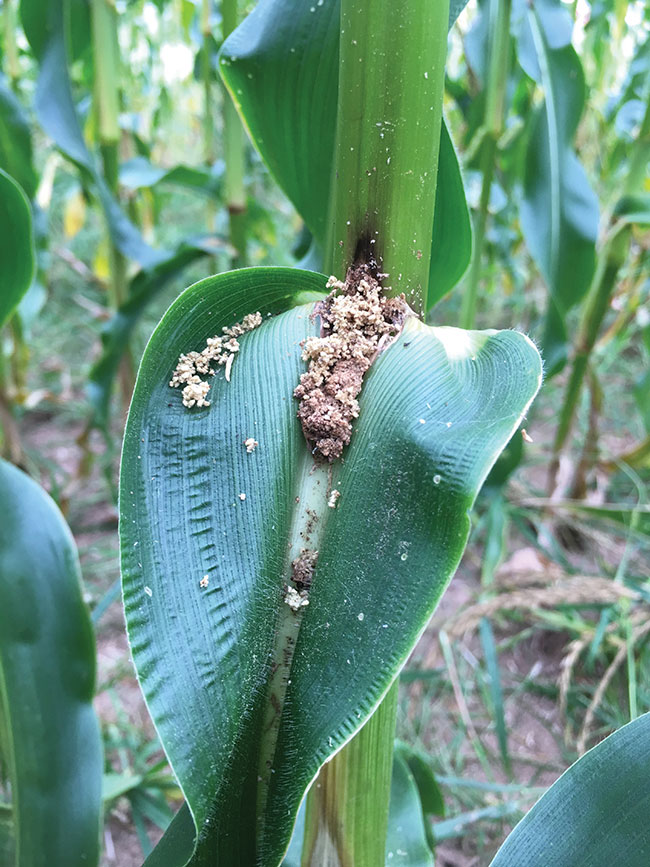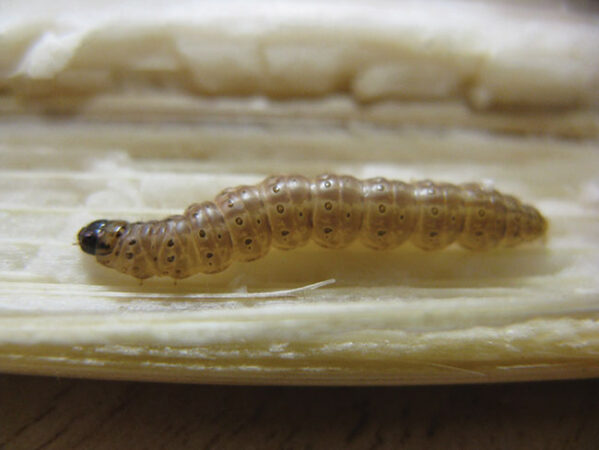
Features
Corn
Insect Pests
Return of the European corn borer
European corn borer is popping up again as a pest to monitor.
November 14, 2023 By Alex Barnard
 European corn borer feeding in Cry1F corn near Truro in 2018, the first documented case in North America of Bt resistance in this insect.
Photos courtesy of Jocelyn Smith.
European corn borer feeding in Cry1F corn near Truro in 2018, the first documented case in North America of Bt resistance in this insect.
Photos courtesy of Jocelyn Smith. Don’t call it a comeback – European corn borer has been here for years. And yet, due to the efficacy of pest management measures developed in the mid-1990s, the once-extremely damaging insect has been essentially a non-issue in the past couple decades. Unfortunately, that appears poised to change.
European corn borer (ECB) is an invasive pest from Europe that arrived in North America in the early 1900s. Since then, it has “spread throughout any region of North America where we grow corn,” says Jocelyn Smith, a research scientist at the University of Guelph, Ridgetown Campus, in an interview with Top Crop Manager. The adult ECB is a small beige moth that can fly between fields to lay eggs; but it is the immature stage, the larva or caterpillar, that causes a great deal of damage to corn yield and standability, as well as any of the 200 other plants that will host the pest.
“When they hatch, the little larvae bore their way into the midrib of the leaves and eventually into the stalks, and they tunnel their way through [the plant] during their development and feed on the stalk tissue – the interior – and create holes,” says Smith.
“So, you have disruption of the physiology of the plant, which can result in yield loss, but [the larval feeding] can also result in stalk rots and ear rots, because it [allows] other fungal pathogens to get into the plant.”
Smith notes that, before the invention of Bt corn, which expresses insecticidal proteins from the bacterium Bacillus thuringiensis, managing ECB cost North American corn growers about $1 billion per year.
At this year’s Southwest Crop Diagnostic Days, held annually at the University of Guelph’s Ridgetown Campus, Smith, along with Tracey Baute, field crop entomologist with the Ontario Ministry of Agriculture, Food and Rural Affairs (OMAFRA), and Yasmine Farhan, University of Guelph research associate, held a session for attendees on the pest and why it’s set to make a comeback in Ontario agriculture, as well as what to watch for.
Baute noted that European corn borer hasn’t been much of an issue since Bt corn was developed to counter it more than 25 years ago. The effectiveness of Bt corn may have been a mixed blessing, as the thorough control it provided led to the development of some bad habits – and resistance in the pest. Continuous corn cropping and repeated use of the same Bt traits – particularly Cry1 – are likely culprits. Now, three of the four Bt proteins available have been compromised.
In 2018, a Bt corn hybrid with the Cry1F protein was found with ECB damage in a few fields near Truro, N.S. Smith and Art Schaafsma, a professor at the University of Guelph, Ridgetown Campus, checked for Cry1F resistance in the local ECB populations. Upon testing, they found that all of the populations they sampled from the Truro area were highly resistant to Cry1F.
ECB populations resistant to at least one Cry1 trait were found in Quebec (2019) and Manitoba (2020), as well.
The four Bt proteins considered high-dose toxins against ECB are Cry1F, Cry1Ab, Cry1A.105, and Cry2Ab2. It’s recommended to use Bt corn with Cry1 or Cry2 traits either in rotation with other traits, or to use a hybrid with multiple traits pyramided together. Using multiple modes of action means less risk of the pest developing resistance to a single trait; rotating traits has a similar effect across seasons.
However, the regions where resistance breakdown has been found have shorter seasons and smaller markets than the U.S. corn belt or Ontario, so the Bt hybrids being sold and grown in those areas sometimes included only single-toxin varieties. Hybrids that rely on one Bt toxin increase selection pressure and make the development of resistance more likely and shorten the timeline of that resistance development.

The European corn borer’s larva attacks corn stalks and kernels, affecting both yield and quality.
Managing resistant populations
“When we think about resistance management, the bottom line is you always have to keep the insects guessing,” Smith says. “If you put the same management to them all the time, chances are they’re going to figure out and develop resistance. It’s just the way it works with insects because there’s so numerous, they reproduce like crazy, they’re overturning genes way faster than you think.”
Smith and Baute both recommend reducing the use of Bt corn hybrids in areas where ECB populations are low, or rotating between Bt hybrids and non-Bt corn when possible.
If there are other options available in your region, do not grow the single-toxin Bt hybrids. Follow refuge recommendations, or plan for a refuge in your fields.
If you find ECB damage or suspect you have a resistant population in your field, Smith recommends calling your seed corn provider, an extension entomologist in your area, or an agronomist.
“You want to get someone in the field to have a look and verify what’s really happening. Also, do gene checks to make sure the plants are expressing the proteins that we hope they are.”
Another option is to chop down the remaining corn stalks at the end of the season.
“[ECB] burrow their way down to the very bottom of the corn stalk – within the bottom 30 centimeters or so – to overwinter as a late instar,” Smith says. “So, if you destroy those, you’re probably going to kill a lot of the population off.”